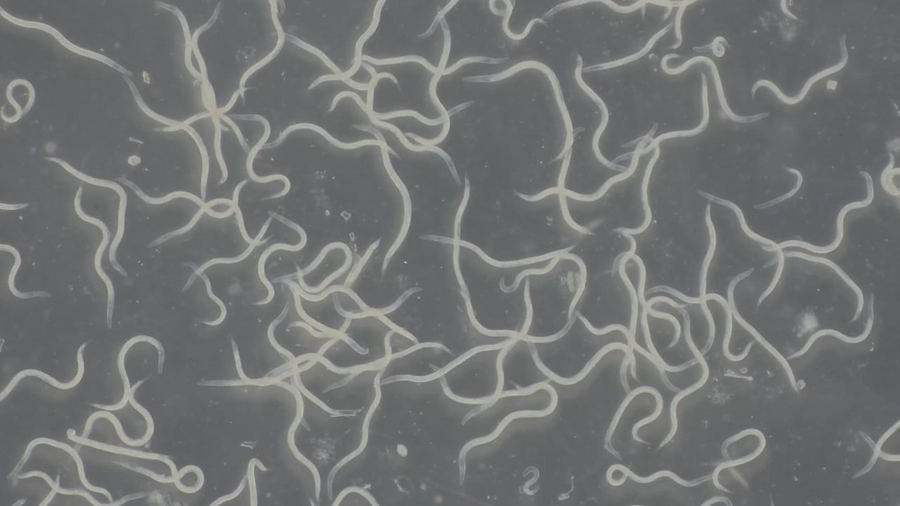Control caterpillars with beneficial nematodes
Beneficial nematodes or entomopathogenic nematodes are mainly known for the biological control of soil pests such as thrips pupae, and larvae of sciarid flies and several beetles. Research and field experience however show that beneficial nematodes are also very effective on foliage-feeding pests. A fact that offers growers many new opportunities the biological control of caterpillars.
Our nematode products can be used in conventional, organic or zero residue growing methods in a wide range of crops; fruits, vegetables and ornamental crops.
5 reasons to use nematodes
-
Effective control of many caterpillars
-
Pests cannot develop resistance
-
Less or no chemical pesticides needed
-
No harmful residue on your crop
-
Safe to use
Biological control of caterpillars
Beneficial nematodes can be used for the biological control of many different caterpillar species, including Tomato leafminer (Tuta absoluta), Tomato looper (Chrysodeixis chalcites), European pepper moth (Duponchelia fovealis), Silver Y moth (Autographa gamma), beet armyworm (Spodoptera exigua), and Mirid bugs such as Nesidiocoris tenuis.
How nematodes control caterpillars
Beneficial nematodes are an effective tool to control caterpillars. After application, the nematodes search for their prey. Once they have found a host insect, they penetrate it through its natural body openings or skin. The nematodes then release the pathogenic bacteria they carry with them. These bacteria kill the insect and digest it from the inside. The nematodes feed on the tissues of the dead caterpillar which dies within a few days. When applied correctly, beneficial nematodes significantly reduce pest pressure, resulting in a healthier crop and higher yields.
Which nematodes control caterpillars?
The beneficial nematodes produced by Koppert have been selected to target specific caterpillar species, and Koppert produces specific strains of Steinernema feltiae and Steinernema carpocapsae for this purpose.
Unlike chemical pesticides, which trigger an immune response in pests enabling them to adapt, nematodes remain highly effective over time. Free of concerns about the diminishing performance of conventional pesticides and even pesticide resistance, growers rely on nematodes as a permanent solution for biological crop protection. Beneficial nematodes are also safe for growers and consumers alike. Nematodes do not leave any harmful residue on crops, which make them safe for the growers who handle them and the people who consume them.
Efficacy of nematodes for controlling caterpillars
Beneficial nematodes control caterpillars effectively. Depending on circumstances at spraying, spraying technique and caterpillar species, an efficacy of 50 to 80% can be achieved.
Nematode products to control caterpillars
R&D departments at several Koppert locations have been researching foliar applications of our nematodes for years. Laboratory and field experience show that Entonem and Capsanem are significantly effective against a variety of caterpillars. It also shows that while nematodes move most efficiently in a liquid layer, a dry leaf surface does not stop the nematodes. Depending on climatic conditions, nematodes survive on the leaf surface for many hours to several days.
Correct application for best results
To ensure the best results, spray when:
- Relative humidity is high (> 75%) continuously for several hours after application
- Temperature is ideally within optimal range of 13 – 30 °C.
- Solar radiation is low
Usually evenings or early mornings are suitable timings for application. An adjuvant is recommended. Check the Entonem and Capsanem product page for detailed advice on application, handling and storage.
Nematodes and chemicals
Nematodes are quite insensitive to many types of pesticides and can thus be sprayed easily after a pesticide treatment or even sometimes tank-mixed. In general, tank mix with foliar fertilizers must be avoided.
FAQs
On this page, you find listed questions and answers about nematodes in general, their application, shelf life, storage advice, or specific regulations for using nematodes in your region and crop.
More than 35 years of Experience
Koppert started producing nematodes in 1986. Many years of experience have gone into the selection, production, formulation, and quality control of these nematodes. Each of the entomopathogenic nematodes produced by Koppert has been selected to target specific pest insects. Koppert produces specific strains of Steinernema feltiae, Steinernema carpocapsae and Heterorhabditis bacteriophora.
